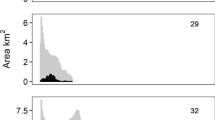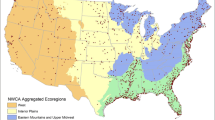Abstract
Environmental monitoring typically falls into one of two broad categories. Targeted designs, utilizing fixed stations, focus on describing and quantifying impacts, tracking trends, and assessing compliance with regulatory guidelines or limits. Probabilistic designs, in contrast, draw sampling stations at random from an area or region, and the stations are used to describe conditions in the region of interest based on a subpopulation of sites. These two design approaches are usually viewed as mutually exclusive, with randomized designs used for broader regional assessments of overall ambient condition and targeted designs for demonstrating regulatory compliance and/or characterizing specific, localized impacts. Combining elements of both approaches into a single design provides benefits not available from either design alone. Embedding targeted monitoring within the framework of a probabilistic design enables data from targeted stations to be viewed in a more accurate regional context and provides a consistent background against which to identify characteristic regional patterns of contamination and impact. We use the San Gabriel River Regional Monitoring Program, recently implemented in southern California, to illustrate the structure of a hybrid design and how it enables data analyses and assessments that provide a more complete picture of conditions in the watershed. For example, the hybrid design showed that approximately 80% of the metals levels at compliance sites were below the 25th percentile of the overall watershed condition as indicated by the probabilistic sampling.
Similar content being viewed by others
References
Adams, S. M., Hill, W. R., Peterson, M. J., Ryon, M. G., Smith, J. G., & Stewart, A. J. (2002). Assessing recovery in a stream ecosystem: Applying multiple chemical and biological endpoints. Ecological Applications, 12, 1510–1527.
Alexander, R. B., Boyer, E. W., Smith, R. A., Schwarz, G. E., & Moore, R. B. (2007). The role of headwater streams in downstream water quality. Journal of the American Water Resources Association, 43, 41–59.
Barbour, M. T., Gerritsen, J., Griffith, G. E., Frydenborg, R., McCarron, E., White, J. S., et al. (1996). A framework for biological criteria for Florida streams using benthic macroinvertebrates. Journal of The North American Benthological Society, 15, 185–211.
Beschta, R. L. & Platts, W. S. (1986). Morphological features of small streams: Significance and function. Water Resources Bulletin, 22, 369–379.
Collier, K. J. (1995). Environmental factors affecting the taxonomic composition of aquatic macroinvertebrate communities in lowland waterways of Northland, New Zealand. New Zealand Journal of Marine and Freshwater Research, 29, 453–465.
Collins, J. N., Stein, E. D., Sutula, M., Clark, R., Fetscher, A. E., Grenier, L., et al. (2006). California Rapid Assessment Method (CRAM) for Wetlands and Riparian Areas. Available at http://www.cramwetlands.org.
Cuffney, T. F., Meador, M. R., Porter, S. D., & Gurtz, M. E. (2000). Responses of physical, chemical, and biological indicators of water quality to a gradient of agricultural land use in the Yakima River Basin, Washington. Environmental Monitoring and Assessment, 64, 259–270.
Diamond, J. (2006). Revised analyses of biological data to evaluate tiered aquatic life uses (TALU) for Southern California coastal streams. Report prepared for Susan Jackson (EPA HECD) and Terry Fleming (EPA Region 9) by Tetra Tech, Inc., 400 Red Brook Blvd, Ste 200, Owings Mills, MD 21117.
Dietrich, W. E, & Dunne, T. (1993). The channel head, in channel network hydrology. In K. Beven & M. J. Kirkby (Eds.). New York, John Wiley and Sons, pp. 175–221.
Downes, B. J., Lake, P. S., Schreiber, E. S. G., & Glaister, A. (2000). Habitat Structure, Resources and Diversity: The Separate Effects of Surface Roughness and Macroalgae on Stream Invertebrates. Oecologia, 123, 569–581.
Izbicki, J. A. (2007). Physical and temporal isolation of mountain headwater streams in the Western Mojave Desert, Southern California. Journal of the American Water Resources Association, 43, 26–40.
Lepori, F., Palm, D., & Malmqvist, B. (2005). Effects of stream restoration on ecosystem functioning: Detritus retentiveness and decomposition. Journal of Applied Ecology, 42, 228–238.
Los Angeles and San Gabriel Rivers Watershed Council (LASGRWC) (2007). Annual Report on Monitoring Activities. Los Angeles, CA. 49 pp. Available at http://www.lasgrwc.org.
Los Angeles County Sanitation Districts (LACSD) (2005). Summary of existing monitoring programs in the San Gabriel River watershed. Prepared for the Los Angeles Regional Water Quality Control Board. 20 pp. Available at http://www.lasgrwc.org.
Los Angeles County Sanitation Districts (LACSD) (2006). San Gabriel River Regional Monitoring Program. Prepared for the Los Angeles Regional Water Quality Control Board (updated August 2006). 83 pp. Available at http://www.lasgrwc.org.
McDonald, T. (2003). Review of environmental monitoring methods: Survey designs. Environmental Monitoring and Assessment, 85, 277–292.
Meyer, J. L., Strayer, D. L., Wallace, J. B., Eggert, S. L., Helfman, G. S., & Leonard, N. E. (2007). The contribution of headwater streams to biodiversity in river networks. Journal of the American Water Resources Association, 43, 86–103.
Ode, P. R., Rehn, A. C., & May, J. T. (2005). A quantitative tool for assessing the integrity of Southern Coastal California streams. Environmental Management, 35(4), 493–504.
Quinn, J. M., Cooper, A. B., Davies-Colley, R. J., Rutherford, J. C., & Williamson, R. B. (1997). Land use effects on habitat, water quality, periphyton, and benthic invertebrates in Waikato, New Zealand, Hill-Country streams. New Zealand Journal of Marine and Freshwater Research, 31, 579–597.
Roth, N., Southerland, M., Chaillou, J., Klauda, R., Kazyak, P., Stranko, S., et al. (1998). Maryland biological stream survey: Development of a fish index of biotic integrity. Environmental Monitoring and Assessment, 51, 89–106.
Stein, E. D. & Ackerman, D. (2007). Dry weather water quality loadings in arid, urban watersheds of the Los Angeles Basin, California, USA. Journal of the American Water Resources Association, 43, 398–413.
Stevens, D. L. (1997). Variable density grid-based sampling designs for continuous spatial populations. Environmetrics, 8, 167–195.
Stevens, E. L. & Olsen, A. R. (2004). Spatially-balanced sampling of natural resources. Journal of the American Statistical Association, 99(465), 262–278.
Southern California Coastal Water Research Project (SCCWRP) (2003). Southern California Bight 1998Regional Monitoring Program. SCCWRP Technical Report #386. 29 pp. Available at http://www.sccwrp.org.
Suren, A. M., & McMurtrie, S. (2005). Assessing the effectiveness of enhancement activities in urban streams: II. Responses of invertebrate communities. River Research and Applications, 21, 439–453.
U.S. Environmental Protection Agency (USEPA) (2002). Research Strategy: Environmental Monitoring and Assessment Program. Office of Research and Development. Research Triangle Park. 78 pp. http://www.epa.gov/emap/html/pubs/docs/resdocs/resstrat02.html.
U.S. Environmental Protection Agency (USEPA). (2006a). Aquatic Resources Monitoring Web Site. http://www.epa.gov/nheerl/arm/.
U.S. Environmental Protection Agency (USEPA). (2006b) Aquatic Resources Monitoring—Design. http://www.epa.gov/nheerl/arm/designpages/monitdesign/sample_size.htm.
U.S. Environmental Protection Agency (USEPA). (2007). Environmental Monitoring and Assessment Program. http://www.epa.gov/emap/.
Author information
Authors and Affiliations
Corresponding author
Rights and permissions
About this article
Cite this article
Stein, E.D., Bernstein, B. Integrating probabalistic and targeted compliance monitoring for comprehensive watershed assessment. Environ Monit Assess 144, 117–129 (2008). https://doi.org/10.1007/s10661-007-9950-5
Received:
Accepted:
Published:
Issue Date:
DOI: https://doi.org/10.1007/s10661-007-9950-5




